
Until recently, things had been looking pretty dire for the Sehuencas water frog.
The species, officially known as Telmatobius yuracare, hadn’t been spotted in the wild for more than a decade, and scientists feared the frogs had been completely wiped out from the Bolivian cloud forests they once called home. Only Romeo, a single male that had been captured in 2008, was known to remain in captivity at the Alcide d’Orbigny Natural History Museum in Bolivia, where he’s since lived under the care of researchers hoping to save his species.
Ten years later, they may have finally succeeded — thanks to a bit of matchmaking.
When Romeo was first collected, researchers recognized that the species were in trouble. They had expected to find more of his kind in order to start a breeding program. But despite his piercing, green-speckled eyes and friendly face, they had no luck finding him a mate. Numerous expeditions turned up not even a single individual. And, at 10 years old, “the world’s loneliest frog” seemed to be running out of time.
On Valentine’s Day 2018, scientists at the museum and the Global Wildlife Conservation partnered with Match.com to create an online dating profile for Romeo, hoping to raise awareness and funds to support the search for a mate.
Following the success of the campaign, which raised $25,000 from Romeo fans, they launched several expeditions to locations in Bolivia’s lush montane forests where the frogs had historically been found.

Much of the frogs’ original habitat has been destroyed by factors like pollution and climate change. This habitat loss, combined with a deadly disease and invasive trout that target their eggs have severely lowered their numbers, according to the Global Wildlife Conservation. Sehuencas tree frogs are so scarce that even locals didn’t recognize the animal from photos and videos.
And to make matters even more difficult, the aquatic frogs rarely surface from below the water, meaning the team had to get used to being soaked.
However, their persistence paid off. Eventually, the researchers recovered five of the frogs — including a possible match for Romeo, named Juliet.

Now, they plan to create a conservation breeding program with the goal of someday reintroducing the frogs to the wild. In the meantime, they’ll continue their explorations in the field to see if there are more frogs out there.
First, though, the rescued frogs must be quarantined to help them adjust to their new environment. They’ll also receive treatment for chytridiomycosis, an infectious disease that can lead to mass die-offs in amphibians, and which the scientists believe is partly responsible for the steep decline of not just Sehuencas water frogs, but other amphibians that live in the same streams.
Once abundant as tadpoles in small streams in Bolivia’s forest, scientists suspect that the population is now so small that it can’t be sustained long-term in the wild. If so, captive breeding is their best hope.

And if Romeo and Juliet don’t hit it off? All isn’t lost. Between the two females and four males (including Romeo), there are several possible pairings. Plus, sperm and eggs are being collected from all the frogs so in vitro fertilization can be used as a last resort.
But things seem promising.
“Opposites attract,” says Teresa Camacho Badani, the chief of herpetology at the Museo de Historia Natural Alcide d’Orbigny. “While Romeo is very shy, Juliet is not at all! So we think she will make an excellent match for Romeo.”




